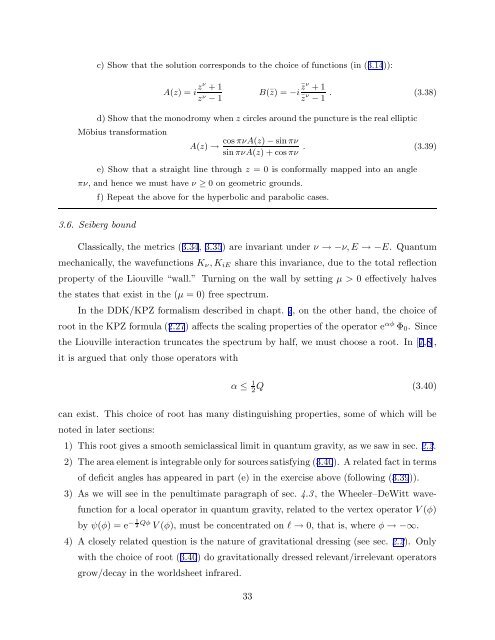arXiv:hep-th/9304011 v1 Apr 5 1993
arXiv:hep-th/9304011 v1 Apr 5 1993
arXiv:hep-th/9304011 v1 Apr 5 1993
Create successful ePaper yourself
Turn your PDF publications into a flip-book with our unique Google optimized e-Paper software.
c) Show <strong>th</strong>at <strong>th</strong>e solution corresponds to <strong>th</strong>e choice of functions (in (3.14)):<br />
A(z) = i zν + 1<br />
z ν − 1<br />
B(¯z) = −i ¯z ν + 1<br />
¯z ν − 1 . (3.38)<br />
d) Show <strong>th</strong>at <strong>th</strong>e monodromy when z circles around <strong>th</strong>e puncture is <strong>th</strong>e real elliptic<br />
Möbius transformation<br />
cos πνA(z) − sin πν<br />
A(z) →<br />
sin πνA(z) + cos πν . (3.39)<br />
e) Show <strong>th</strong>at a straight line <strong>th</strong>rough z = 0 is conformally mapped into an angle<br />
πν, and hence we must have ν ≥ 0 on geometric grounds.<br />
f) Repeat <strong>th</strong>e above for <strong>th</strong>e hyperbolic and parabolic cases.<br />
3.6. Seiberg bound<br />
Classically, <strong>th</strong>e metrics (3.34, 3.35) are invariant under ν → −ν, E → −E. Quantum<br />
mechanically, <strong>th</strong>e wavefunctions K ν , K iE share <strong>th</strong>is invariance, due to <strong>th</strong>e total reflection<br />
property of <strong>th</strong>e Liouville “wall.” Turning on <strong>th</strong>e wall by setting µ > 0 effectively halves<br />
<strong>th</strong>e states <strong>th</strong>at exist in <strong>th</strong>e (µ = 0) free spectrum.<br />
In <strong>th</strong>e DDK/KPZ formalism described in chapt. 2, on <strong>th</strong>e o<strong>th</strong>er hand, <strong>th</strong>e choice of<br />
root in <strong>th</strong>e KPZ formula (2.27) affects <strong>th</strong>e scaling properties of <strong>th</strong>e operator e αφ Φ 0 . Since<br />
<strong>th</strong>e Liouville interaction truncates <strong>th</strong>e spectrum by half, we must choose a root. In [7,8],<br />
it is argued <strong>th</strong>at only <strong>th</strong>ose operators wi<strong>th</strong><br />
α ≤ 1 2 Q (3.40)<br />
can exist. This choice of root has many distinguishing properties, some of which will be<br />
noted in later sections:<br />
1) This root gives a smoo<strong>th</strong> semiclassical limit in quantum gravity, as we saw in sec. 2.2.<br />
2) The area element is integrable only for sources satisfying (3.40). A related fact in terms<br />
of deficit angles has appeared in part (e) in <strong>th</strong>e exercise above (following (3.39)).<br />
3) As we will see in <strong>th</strong>e penultimate paragraph of sec. 4.3 , <strong>th</strong>e Wheeler–DeWitt wavefunction<br />
for a local operator in quantum gravity, related to <strong>th</strong>e vertex operator V (φ)<br />
by ψ(φ) = e − 1 2 Qφ V (φ), must be concentrated on l → 0, <strong>th</strong>at is, where φ → −∞.<br />
4) A closely related question is <strong>th</strong>e nature of gravitational dressing (see sec. 2.2). Only<br />
wi<strong>th</strong> <strong>th</strong>e choice of root (3.40) do gravitationally dressed relevant/irrelevant operators<br />
grow/decay in <strong>th</strong>e worldsheet infrared.<br />
33
















